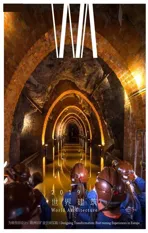鲁尔大都市区后矿业景观:从“第四自然”到“人造景观建筑”,北莱茵-威斯特法伦州,德国
2019-10-17阿克塞尔廷佩TextbyAxelTimpe
阿克塞尔·廷佩 文/Text by Axel Timpe
尚晋 译/Translated by SHANG Jin
在文艺复兴时期,学者区分了3 种形式的自然:第一自然,即未受人类扰动的荒地;第二自然,是人类为农业生产在可耕地、草地和菜园上形成的;第三自然,指所有以欣赏和休闲为目的的人造园。
而后矿业转型创造出了第4 种形式:工业自然。工业遗址作为完全人造的场所重归于大自然的作用,让它们成为主宰。动植物占据着这些遗址,创造出前所未有的自然景象。
各种自然与“人类世”的概念因此可以帮助我们更好地理解欧洲景观建筑的后矿业设计。例如,鲁尔区是原先西德矿业和钢铁业的中心,如今则展示出景观建筑师用全部四种形式的自然实现的后矿业设计。通过这些设计,设计师在为能够应对社会和环境现实挑战的宜居未来之地努力。
地区公园“埃姆舍尔景观公园”是鲁尔大都市区的绿色基础设施支柱。在这里,农林业的第二自然占公园面积超过50%。除此之外,“埃姆舍尔景观公园”包含了许多融合矿业遗产、工业自然和新景观设计的地标。下面介绍了各种案例及其因用自然的不同途径:
(1)“工业森林莱茵易北”项目,通过最小干预发现后工业荒地的美;
(2)埃森“关税同盟公园”,将工业自然重新构建为联合国教科文组织世界遗产地“关税同盟煤矿”的组成部分;

1 由鲁尔区联盟管理的埃姆舍景观公园是该地区绿色基础设施的支柱。它东西绵延逾80km,包含大量后矿业地标和公园/The Emscher Landschaftspark managed by Regionalverband Ruhr is the backbone of the region's green infrastructure. It stretches out for more than 80km from East to West and includes numerous post-mining landmarks and parks(图片版权/Copyright: Regionalverband Ruhr)
(3)生物量公园“雨果”和“哈瑟尔”的后矿业设计,原先的褐地成为追求碳中和未来的公共空间和自然生产力之地;
(4)跨学科项目“凤凰湖区与凤凰西区”,水及其自然化处理是多特蒙德原钢铁工业遗址再利用的关键要素。
所有这些公园和绿色空间都设计在与鲁尔区矿业历史紧密相联的后工业遗址上。它们以不同的形式让自然融入其中,创造出“人类世”的景观建筑。在这里,自然与文化之间不再有界限,而人与自然创造出融合自然作用与人类使用的新环境。
In the renaissance, scholars distinguished three forms of nature: the first nature, which is wilderness undisturbed by man; the second nature that is shaped by man for agricultural production on arable fields, grassland and in vegetable gardens; and the third nature meaning/comprising all the man-made gardens for esthetic enjoyment and leisure.
The post-mining transition created a fourth form: the industrial nature. Industrial sites as totally anthropogenic places are re-captured by natural processes. They re-gain the upper hand. Plants and animals conquer these sites and create images of nature previously unknown.
This concept of different natures and the Anthropocene era may thus help us to understand the post-mining designs of European landscape architecture better. The Ruhr region - the former heart of Western Germany's mining and steel industry - displays, for example, actual post-mining designs of landscape architects, using all four forms of nature. With the designs, the planners strive for livable future places that respond to the actual challenges of society and environment.
The "Emscher Landschaftspark" as regional park constitutes the green infrastructure backbone of the Ruhr Metropolis. Here, the second nature of agriculture and forestry covers more than 50% of the park's surface. Apart from that, the "Emscher Landschaftspark" embeds numerous lighthouse locations where mining heritage, industrial nature and new landscape designs meet. The following showcases and their different strategies of working with nature are presented here:
(1) The project "Industriewald Rheinelbe",where minimal interventions discover the beauty of post-industrial wilderness;
(2) The "Zollverein Park" in Essen that reframes industrial nature as component of the UNESCO World heritage site "Zeche Zollverein";
(3) The post-mining designs of the biomass parks "Hugo" and "Hassel" - former brownfields becoming public spaces and sites of natural productivity for a carbon-neutral future;
(4) The interdisciplinary project of "PHOENIX See and PHOENIX West" where water and its natural treatment are the key element for redeveloping Dortmund's former steel industry sites.
All these parks and green spaces were designed on post-industrial sites that are tightly linked to the mining history of the Ruhr region. They blend nature in its different forms and create landscape architecture for the Anthropocene era, where the boundary between nature and culture cannot be traced any more,and where man and nature create new environments integrating natural processes and human uses.
工业森林莱茵易北:后矿业荒地的最小干预
莱茵易北煤矿于1861 年开采,1928 年停工。此后,第四自然开始以本土和外来植物组成的林地覆盖这个大规模改造的遗址。这些植物能在极端的土壤和微气候条件下生长。只有矿渣堆在不断积累其他矿井的废物。为了让这个遗址再度引人瞩目、便于游赏,林地里和矿渣堆顶放上了艺术家赫尔曼·普里甘的大地艺术作品,并由一位护林员向游客介绍这个新丛林的特殊植物。
Industriewald Rheinelbe: minimal interventions in post-mining wilderness
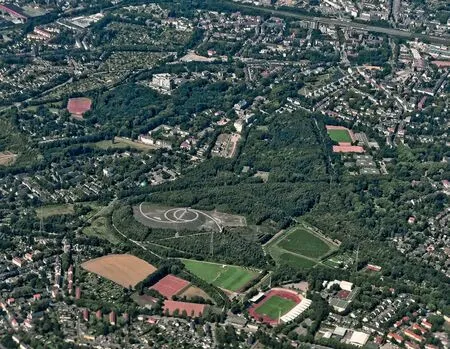
2 莱茵易北遗址包含工业林地和艺术家赫尔曼·普里甘的大地艺术作品。矿渣堆顶去掉了所有植被。这座黑色的小山被工业林地的第四自然包围,成为该地区的一个重要地标/The Rheinelbe site with the industrial woodland and land art interventions by artist Herman Prigann. All vegetation has been removed from the top of the Rheinelbe slagheap. The black mountain is surrounded by the fourth nature of industrial woodlands and an important landmark for the region(摄影/Photo: RaBoe/Wikipedia)

3 这座天梯通向赫尔曼·普里甘用原矿业建筑的混凝土构件创造的地标/Steps into the sky lead to the landmark crafted by Herman Prigann out of concrete elements of the former mining buildings(摄影/Photo: Axel Timpe)
The Rheinelbe mine was opened in 1861 and stopped its activity on the site in 1928. Since then fourth nature started to cover the deeply remodeled site with a woodland composed of indigenous and invasive species, which could grow in the extreme soil and microclimate conditions. Only the slagheap was continuously being built-up with material from other mines. To make the site attractive and accessible again, Land-Art interventions by artist Herman Prigann were placed in the woodland and on top of the slagheap. A forests guard introduces visitors to the special vegetation of the new jungle.
项目信息/Credits and Data
项目/Project: 工业森林莱茵易北/Industriewald Rheinelbe
地点/Location: 德国盖尔森基兴/Gelsenkirchen, Germany
概念设计/Concept: IBA Emscher Park
大地艺术设计/Land Art: Hermann Prigann
责任机构/Responsible Institutions: Ministry for Urban Planning and Ministry of the Environment of the Federal State of North Rhine-Westphalia
执行机构/Executing Bodies: Landesbetrieb Wald und Holz NRW and NRW urban GmbH&Co kg
基底面积/Built Area: 36hm2
设计开始时间/Design Start Time: 1995(IBA埃姆舍尔
公园第一次概念研讨会/First concept workshop at IBA Emscher Park)
施工时间/Realisation Period: 1996(开始设置护林员,至今/Start of implementation with forest ranger staff hired,ongoing until today);1996-2003(逐步实施赫尔曼·普里甘的大地艺术作品/Step-by-step implementation of Land Art by Hermann Prigann)
埃森关税同盟公园:重构工业自然
Zollverein Park Essen: reframing industrial nature

4 关税同盟公园总平面,原关税同盟煤矿在东,关税同盟焦化厂在西。公园的设计是逐步实施的,并考虑了原有的微环境和植被。红线标出的环形步道限定了公园的内核,它又被绿色标出的工业林地包围/General plan of the Zollverein Park with the former Zollverein mine in the East and the Zollverein Coking Plant in the West. The design for the park is implemented step by step and with respect to the existing micro-situations and the vegetation. The ring promenade represented as a red line confines the inner core of the park which is also surrounded by the industrial woodlands represented in green (规划/Plan:Planergruppe Oberhausen)

5 环形步道被设计成一条10m宽的廊道。它从天然林地的第四自然中穿过,打开了面向遗产建筑的视野,并大受体育活动欢迎。环形步道是关税同盟遗址照明方案的一部分/The ring promenade has been designed a 10m wide corridor.It cuts through the fourth nature of the spontaneous woodland,opens the view on the heritage buildings and is popular for sports activities. The ring promenade is part of the lighting concept of the Zollverein site
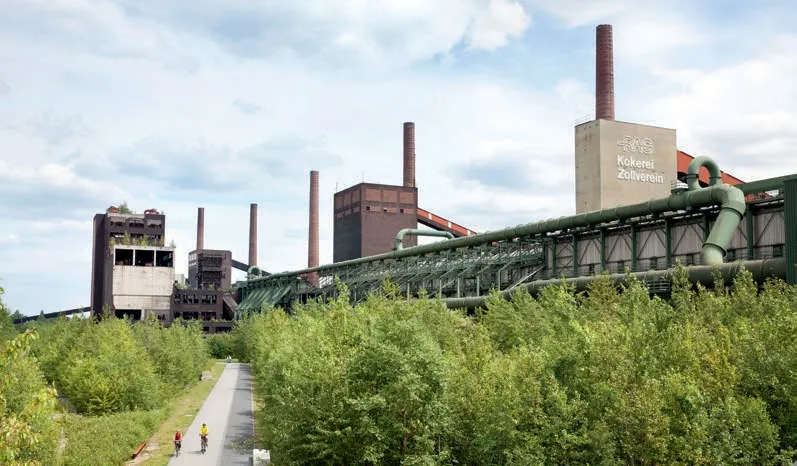
6 环形步道从后工业林地中穿过/The ring promenade cutting though the post-industrial woodland(5.6摄影/Photos: Claudia Dreyße)
项目信息/Credits and Data
项目/Project: 关税同盟公园/Zollverein Park
地点/Location: 德国埃森/Essen, Germany
主持建筑师/Principal Architect: Planergruppe Oberhausen
艺术设计/Art: Observatorium, Rotterdam
信号设计/Signalisation: F1irstdesign, Cologne
灯光概念设计/Lighting Concept: Licht Kunst Licht
基底面积/Built Area: 80hm2
造价/Cost: 约1500万欧元/Approx 15M EUR
设计开始时间/Design Start Time: 2005
施工时间/Construction Period: 2005-2006(一期/1st stage),2007-2009(二期/2nd stage),2010-2014(三期/3rd stage),2016-2020(四期/4th stage)
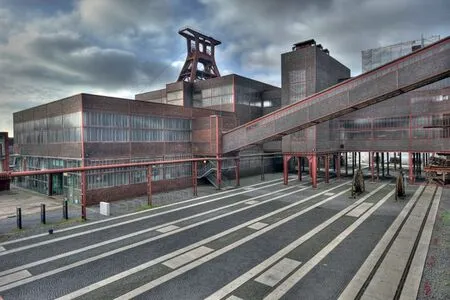
7 所谓的轨道大街位于公园的中心。在它被遗产建筑包围的地方,所有的天然植被都被去掉,使它成为遗产地的中心广场,可用于各种临时活动/The so called track boulevard is at the heart of the park. In its part surrounded by the heritage buildings,all spontaneous vegetation has been removed and it is the central square of the heritage site, which can be used for temporary events(摄影/Photo: Thomas Mayer)

8 在轨道大街上,原先运送煤炭的火车轨道被改造为公园游客的小径。景观建筑师改变了第四自然的植被。那是在工业活动停止后形成的阳光明媚的桦树林。为营造通透感,灌木和部分树木被去掉/On the track boulevard the former train tracks for transporting coal have been transformed into pathways for the park visitors. The landscape architects have transformed the fourth nature vegetation, which developed after the end of the industrial activity to a birch grove full of light. Bushes and parts of the trees have been removed to create transparency(摄影/Photo: Claudia Dreyße)

9 公园小径和刺槐树。第四自然也能创造出吸引人的花草地,并有很高的生物多样性价值/The park alley with its Robinia pseudoacazia "Frisia" trees. Forth nature can also create attractive flower arrangements and has a high biodiversity value

10 公园小径是公园中为数不多的新增要素之一。它从轨道大街上跨过,与公园各处及工业遗产建筑相连。那里种有刺槐,并与桦树林的天然植物融为一体/The park alley is one of the few newly added elements in the park. It crosses the track boulevard to connect the different parts of the park and the industrial heritage building. Its Robinia pseudoacazia "Frisia"trees have been planted, but blend into the spontaneous vegetation of the birch grove(9.10摄影/Photos: Thomas Mayer)
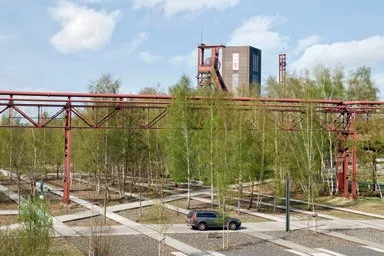
11 轨道大街和公园小径/Track boulevard and park alley

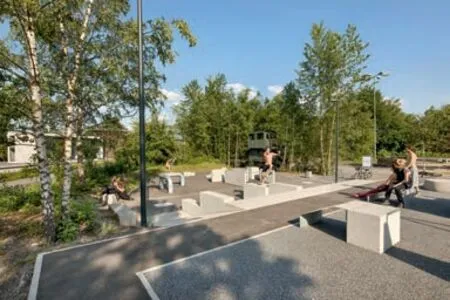
12.13 公园中的多功能活动岛,用于照片中的跑酷运动/Multifunctional activity island in the park, used for Parkour sports on the photos(11-13摄影/Photos: Claudia Dreyße)
盖尔森基兴生物量公园:生产性公共公园
将工业遗产与第四自然结合在一起的办法并不能用到每个后工业遗址上。后矿业未来也需要生产能源的新方式。生物量可以成为一种解决方案。盖尔森基兴的两座生物量公园以2~3 年轮伐短期林的形式,将第二自然重新引入城区。与此同时,游客能亲身体验这种不断变化的生产性景观。
Biomasseparks Gelsenkirchen: productive public parks
Combining industrial heritage and fourth nature are not the solution to be applied on every post-industrial site. The post-mining future also needs new ways of energy production. Biomass can be one solution for it. The two biomass parks in Gelsenkirchen reintroduce second nature to the urban areas in the form of short rotation forests to be harvested every 2~3 years. At the same time,visitors experience this ever changing productive landscape.

14 雨果生物量公园的设计/Design for Biomassepark Hugo(规划/Plan: lohrberg stadtlandschaftsarchitektur, Stuttgart)

15 盖尔森基兴-布尔城市肌理中的雨果生物量公园位置/The site of Biomassepark Hugo in the urban fabric of Gelsenkirchen-Buer(规划/Plan: RWTH Aachen University, Institute of Landscape Architecture)

16 哈瑟尔生物量公园的设计,生物量作物在公园南部/Design for Biomassepark Hassel with the biomass plantations in the southern part of the park

17 短期轮伐林形成了第二自然的地块,它与后工业公园成为一个整体。通过每3~5年的轮伐,公园的空间特征在开放与封闭之间不断变换/The short rotation forest form block of second nature which are integrated into the post-industrial park. Through harvesting them every 3~5 years, the spatial character of the park is constantly changing between open and closed spaces(16.17规划/Plan: lohrberg stadtlandschaftsarchitektur,Stuttgart)
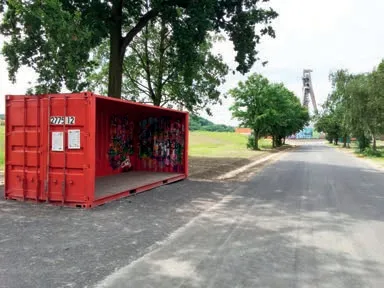
18 雨果生物量公园的入口以原煤矿的井塔为中心。集装箱将包含公园信息/The entrance to Biomassepark Hugo is centred on the shaft tower of the former mine. The container will accommodate information on the park(摄影/Photo:lohrberg stadtlandschaftsarchitektur, Frank Lohrberg)
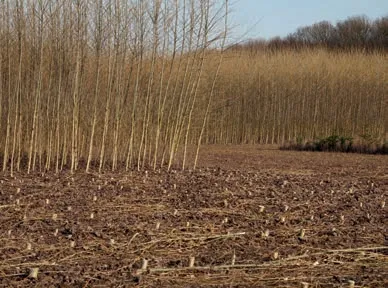

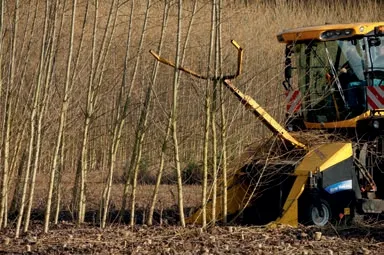
19-21 按地块收割的做法使公园在冬天为之一变。白杨将在次年春夏从留存的根部重新生长出来。几年后达到原先的高度,然后再收割/Blockwise harvesting transforms the park in the winter. The poplars will regrow from their rootstocks within the next spring and summer, reach their previous after a few years to be harvested again(19-21摄影/Photos: RWTH Aachen University, Institute for Landscape Architecture, Jasmin Matros)
项目信息/Credits and Data
地点/Location: 德国盖尔森基兴/Gelsenkirchen, Germany建筑设计/Architect: Lohrberg stadtlandschaftsarchitektur
基底面积/Built Area: 22hm2(雨果生物量公园/Biomassepark Hugo),30hm2(哈瑟尔生物量公园/Biomassepark Hassel)设计时间/Design Period: 2006-2014(雨果生物量公园/Biomassepark Hugo),2012-2014(哈瑟尔生物量公园/Biomassepark Hassel)
施工时间/Construction Period: 2012-2017(雨果生物量公园/Biomassepark Hugo),2016-2020(哈瑟尔生物量公园/Biomassepark Hassel)
多特蒙德凤凰区:城市水体
多特蒙德赫尔德区原来的凤凰炼钢厂从2000年起被改造为集办公、商务、居住、无扰工业和教育为一体的新片区。水作为一种自然要素在这个改造过程中发挥了关键作用。凤凰湖是这个后工业城市发展中最重要的吸引点。作为一个人造生态系统,它以基于自然的方法保持了水质。在凤凰西经济活动区,地表水积蓄在精心设计的沼泽和水池系统中,之后流入埃姆舍尔河中。这一系统有助于城市适应气候变化带来的极端天气。□
PHOENIX Dortmund: Urban Water
The former PHOENIX steelworks in Dortmund's district of Hörde have been redeveloped as new neighbourhoods for offices, business, dwelling,non-disturbing industry and education since the year 2000. Water as a natural feature plays the key role in this development. The PHOENIX lake is the most important attractor for the post-industrial urban development. As a constructed ecosystem it maintains its water quality though nature-based solutions. In the PHOENIX West economic activitiy zone, surface water is retained in a designed system of swales and ponds before running-off into the Emscher river. This system helps the city to adapt to the extreme weather events that it will face due to climate change.□
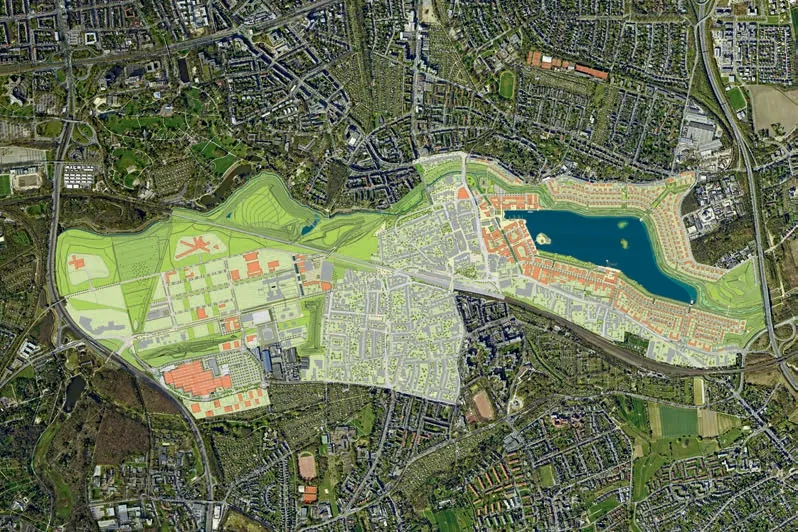
22 总平面;包括东侧的凤凰湖区及凤凰西区。两区由城市中心赫尔德和规划区域北部的埃姆舍河联系起来/Masterplan for the PHOENIX lake area in the East and the PHOENIX West area. The link between the two areas is provided by the Hörde urban centre and the Emscher river in the North of the planned area(图片来源/Sources: SPAP Architektur Stadt Landschaft Dortmund l Stadt Dortmund)

23 1999年的航拍图显示出城市中心赫尔德区东西侧的大型工业区。在随后的几年中,工业装置被拆除,部分运往中国,在那里仍用于炼钢/The aerial photo of 1999 shows the large industrial areas East and West of the urban centre of the Hörde district. During the next years the industrial installations have been dismantled and partly transported to China where they are still used for steel production(图片来源/Sources: Stadt Dortmund)
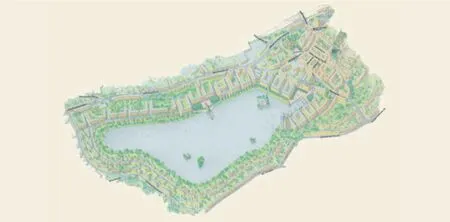
24 1998/1999年诺贝特·克尔岑贝格的凤凰湖设计方案/Design proposal for the PHOENIX lake by Norbert Kelzenberg in 1998/1999(图片来源/Sources: Norbert Kelzenberg,Stadt Dortmund)
项目信息/Credits and Data
地点/Location: 德国多特蒙德/Dortmund, Germany
设计团队/Design Team: City of Dortmund, Norbert Kelzenberg (凤凰湖区/PHOENIX See); stegepartner,Dortmund (凤凰西区规划/Masterplan PHOENIX West)
基底面积/Built Area: 214hm2
设计时间/Design Time: 1998
施工时间/Construction Period: 2004-2011(凤凰湖区/PHOENIX See),2002-至今/2002-Ongoing(凤凰西区/PHOENIX West)

25 沼泽会收集凤凰西区的地表水/Swales collect the surface water on the PHOENIX West site(摄影/Photo: RWTH Aachen University, Institute of Landscape Architecture, Rieke Hansen)

26 用于调控凤凰西区地表水的沼泽,背景为炼钢高炉中保留下来的部分。遗址中留下了两座高炉作为工业遗产,作为导游项目的一部分是可以参观的/Swales for surface water management at PHOENIX West with the conserved part of the blast furnace for steel production in the background.Two furnace units have been conserved on the site as industrial heritage and are accessible as part of guided visits(摄影/Photo: Sebastian Hopp Architectural photographer)
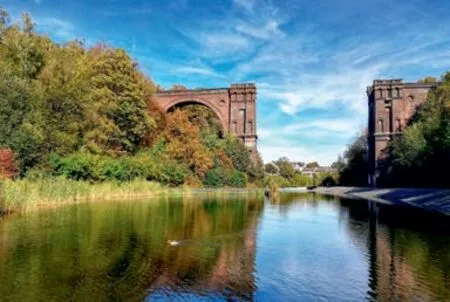
27 凤凰西区收集的地表水先在池中缓冲,之后流入埃姆舍河。通向高炉矿渣堆的铁路桥如今是凤凰西区公园中的一座纪念碑/The surface water collected on the PHOENIX West area is buffered in a pond before running off into the Emscher river. The railway bridge giving access to the slagheap of the furnaces today is a monument in the park area of PHOENIX West(摄影/Photo: Sabina Leopa)
评论
刘伯英:工业革命力量之强大在于它对人类社会的全面改变,包括环境和景观。鲁尔转型的成功也正在于它不仅实现了经济的再发展、社会的再认同,还实现了对环境和景观的再恢复,让烧焦的大地转变为律动的大地。矿渣山与大量保留的工业建构筑物、设施设备、铁路、桥梁、运河共同形成了鲁尔独特的工业文化景观。作者介绍的以第四自然概念为基础的4种景观设计方法,为延续和彰显鲁尔的景观特色增添了新的内涵。
薄宏涛:从第一自然到第四自然,自然不断在人类对其认知和占有的态度变迁中留存着或改变着模式与样貌。从后工业荒地、工业自然、生产性公园到城市水体公园,体现了人类再介入强度的梯级变化。最小干预的后工业荒地是一种对土地精明收缩的认知体现,除了扩张式攫取,人类也可以尝试把产能过剩的土地谨慎地还给自然;重构的工业自然提供了自然和工业交融的对话通径;工业遗存向城市水体公园的转换则提供了土壤生态修复后对城市地产的强劲推动力;生产性公园最令人振奋,这种既可通过第二自然方式进行生态修复,又同时提供互动式参与体验的生态再造模式,让我们拥有了崭新的视角。
Comments
LIU Boying: The power of the industrial revolution lies in its comprehensive changes in human society including the environment and landscape. The success of Ruhr's transition does not only rest with its accomplishment of the redevelopment of economy and social reidentification, but also lies in the recovery of both the environment and landscape that turns the scorched land into a rhythmical land. The slag heaps, a large number of retained industrial structures, facilities and equipment, railways,bridges and canals, together form the unique industrial cultural landscape of Ruhr. The four landscape design approaches based on the concept of the Fourth Nature that are introduced by the author has contributed to new meanings to continue and reveal the landscape characteristics in Ruhr. (Translated by Dandan Wang)
BO Hongtao: From the First Nature to the Fourth Nature, nature constantly preser ves or changes its patterns and appearances in tandem w ith the development o f human's attitudes of understanding and utilisation. From post-industrial wasteland, industrial nature,productive parks to urban water parks, a variety of cases reflect the gradual change of intensity in humanity's re-intervention. Minimal intervention of post-industrial wasteland is a cognitive reflection of smart land contraction. In addition to expansive expropriation, attempts can be made to return to nature land of excess production capacity in a prudent manner. Restructured industrial nature creates a path of dialogue for the integration of nature and industry. Conversion of industrial monuments into urban water parks provides strong impetus to urban real estate after ecological land restoration. Productive parks are most inspiring in that they enlighten us with brand new perspectives in such manner that is capable of both restoring the ecology through the Second Nature and providing interactive and participative patterns of ecological re-creation.(Translated by SHANG Jin)
